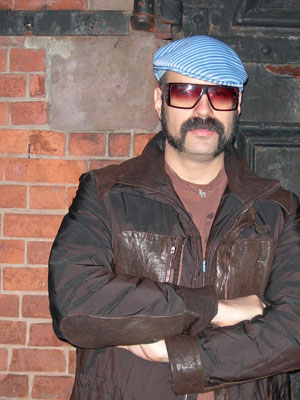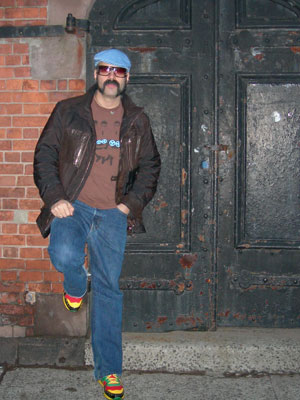
When I arranged to meet Andres Levin outside of his Fun Machine Studios in SoHo, I wasn’t sure I’d recognize him among the pedestrians. I needn’t have worried. Physically, Levin is as distinctive as his music. A stately man with a Franz Joseph beard, wearing his signature cap, sunglasses and day-glo sneakers, he has an air of confidence much older than his 35 years—probably because he is one of Latin music’s most respected musicians and producers.
He said the 14-hour workdays in the studio had caused him to put on a few pounds—weight he hoped to lose once he went on tour again with his band Yerba Buena, whose live show is one of the most compelling and dynamic—and athletic—that I’ve ever seen. Today, I wanted to get some photographs, and Levin knew of an alternative to the studio ambiance.
“There’s a beautiful red-brick wall a block from here,” he says to me as we head up the street from the corner of Prince and Mott. “We did a shoot at this same spot a couple of weeks ago.”
Levin has stepped out of a meeting, and at the moment, he is juggling several projects, most notably the production of a new album by Brazilian pianist and vocalist Eliane Elias. He’s also writing a score for Borderland, a new Zev Berman film. His schedule is intense, but his disposition is affable. He pats his stomach. “Maybe you could crop this out before you run the pictures.”
Last year was especially good to Levin. Yerba Buena released its critically acclaimed Island Life, a Latin-fusion follow-up to the band’s Grammy-nominated debut, President Alien. Levin also produced El Kilo for Cuban hip-hop trio Orishas; the album received a Grammy nomination this year for Best Latin Rock/Alternative Album, but the award went to Shakira. El Kilo brought Cuban hip-hop into the mainstream and exposed listeners to a inimitable blend of Latin rhythms, multi-layered vocal tracks, and surprisingly evocative lyrics about everyday life. As with Ry Cooder and Bill Laswell, scholarly artists who approached their collaboration with Cuban musicians as musicologists, the genuine respect Levin has for Cuban culture radiates from Orishas’s songs.
“There are lots of great records and collaborations to be made [with Cuban musicians],” Levin says. “And I think that Cuban talent will benefit tremendously from outside producers, artists, and production techniques.”
Levin got his start in music production by assisting Nile Rogers, the co-founder of ‘70s supergroup Chic. At Rogers’s studio, Levin worked as an arranger and Synclavier programmer with artists ranging from Diana Ross to the B-52s. Since his childhood days in Venezuela, Levin has felt comfortable in the recording studio.
“My father had an electronic improvisation group in Caracas, and basically, our entire house was a recording studio,” he says. “My musical background has enabled me to communicate well with composers and other artists. But there’s no prerequisite for what you need to know to produce music. Music production is a craft where one can rely on intuition and instinct, as well as musical talent.”
While working with Rogers in New York City, Levin met Arto Lindsay, an integral figure in both avant-garde and Brazilian popular music. By the late ‘80s Lindsay had gone from the abrasive, post-punk improvisation of his no-wave band DNA to a collaboration with keyboardist Peter Scherer called the Ambitious Lovers, an eclectic mix of bossa-nova rhythms, funk, and ironic lyrical twists. Levin assisted with the writing and production of four subsequent Lindsay solo albums—Mundo Civilizado, Noon Chill, Prize, and Invoke.
“Arto and I had a great routine for working together on those albums,” Levin says. “We’d head down to Carnival [in Salvador, Brazil] to write the music.”
The sparse Lindsay-Levin songs blend simple melodic hooks with abstract, visually intense lyrics. This minimalist approach gives enormous weight to the words and notes, as if a conversation is taking place between two free-verse poets who know exactly what they want to say.
“Andres is an awesome songwriter,” Lindsay writes in an email sent from his home in Bahia, Brazil. “Usually we sit down, he with a guitar and me with a pen and paper and go for it. As Andres has gotten busier, he often tries to do several other things while we are trying to compose. Sometimes he writes his best stuff when he is most distracted.” [hear an excerpt of “Over/Run” from Lindsay’s Invoke, co-written with Levin]
“Even though Yerba Buena experiments with many influences, the basis of the group is inspired by the African and Cuban diaspora, where both worlds meet. The music is a bridge between the two cultures.”
Although one might assume that producers reliant on studio tools for editing and processing would use similar technologies for composition, Levin would prefer to capture melodies with acoustic instruments. “A melody in a song can come at any time,” he says. “And the instruments are the most important tools in composition, especially the guitar and piano.”
Levin’s musicianship and production skills gained wide critical acclaim with his work on seminal Colombian rock band Aterciopelados’s Caribe Atómico, which received a Grammy nomination in 1999. Aterciopelados, best known for its driving blend of garage punk, bolero, and playful lyrics, had sought out Levin to take the band’s music in another direction.
“They were searching for a more studio-oriented, layered sound. We really broke new ground in Latin music [with Caribe Atómico]. My philosophy has always been to forget what you’ve done in the past and follow your inspiration.”
Levin played guitar, bass, and keyboard on the album and brought in a plethora of other contributors, including Lindsay, guitar virtuoso Marc Ribot, and Brazilian singer-songwriter Vinicius Cantuária. The album abandons raucous chord progressions in favor of musical textures, and Levin’s penchant for combining electronica, programmed beats, Caribbean rhythms, and acoustic instrumentation is prominently displayed. Caribe Atómico is a testament to Levin’s insatiable desire to continually challenge himself, his fellow musicians, and the limitations imposed on popular music by a market stubbornly resistant to change.
In 2002, Levin co-produced Red Hot and Riot, a musical tribute to the late Nigerian multi-instrumentalist and composer Fela Kuti. Like the other Red Hot albums, it was released to raise awareness about the global AIDS crisis. That same year, Levin and his wife, Cuban singer CuCu Diamantes, formed Yerba Buena, their commercially successful and enormously popular Latin-rock collective. Yerba Buena mixes so many different musical styles that they’re virtually impossible to categorize. In every song, one can hear Afro-Cuban rhythms, along with elements of funk, Nigerian Afrobeat, hip hop, and Motown soul.

“[Before Yerba Buena] I had done a lot of R&B and soul on one end, in addition to urban and Latin material. No one project would combine the two,” Levin says. “CuCu and I were in Nigeria, Cuba, and Bahia the same year and those influences combined to form the Yerba Buena sound. But even though Yerba Buena experiments with many influences, the basis of the group is inspired by the African and Cuban diaspora, where both worlds meet. The music is a bridge between the two cultures.”
In 2003, Yerba Buena released President Alien, which kicks off with “Guajira (I Love U 2 Much),” a hip-hop number built around the vocalists’ staccato-rhyme delivery, while the remaining songs synthesize classic Cuban rhythms and Fela-style horn arrangements. Levin carries the hybridization of influences even further with Island Life, Yerba Buena’s 2005 follow-up, a musical tribute to New York City’s cultural diversity with bilingual rhyming vocals buttressed by house beats, reggaetón rhythms, and samples ranging from the late-great Celia Cruz to President George W. Bush. Island Life’s guest list is too long to mention here, but includes such luminaries as comedian John Leguizamo and revered Latin R&B pioneer Joe Bataan. Although President Alien and Island Life appear to be conceptually different projects with unique internal consistencies, Levin doesn’t see it that way.
“I wouldn’t say that there’s a separate sound on each record. On both records, every song is like a whole different story—another trip into various styles and rhythms. Each track has its own life.”
Yerba Buena hits the road again in April and will perform at the New Orleans Jazz Festival this spring. In the meantime, Levin continues to venture out into other creative outlets. He and Diamantes scored the theme song for the new UPN television series South Beach, and Levin plans to work on additional film projects. He will also curate a series of concerts to honor Fela Kuti for the Brooklyn Academy of Music—a project that was inspired by the Red Hot and Riot album. As many as 25 performers, including Senegalese artists Youssou N’Dour and Baaba Maal, are scheduled to appear on the roster for those December 2006 shows. Levin, who is a huge fan of country music, recently produced “Candy” for Mark Seliger’s Rusty Truck.
Still, while in demand as a producer, Levin seems most focused on carrying Yerba Buena’s music further into uncharted territory.
“Timing is always critical,” he says. “And both fortunately and unfortunately, we’re always ahead of the curve.”


